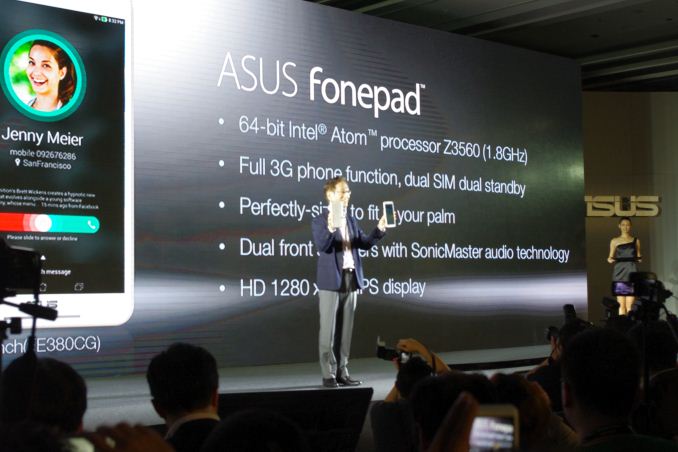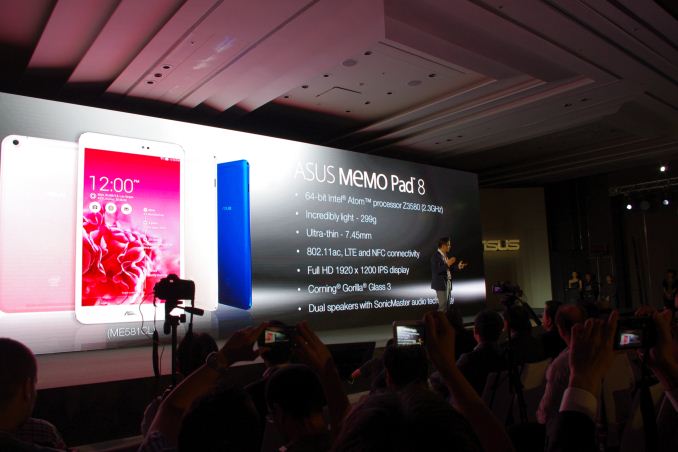Computex 2014: All new Intel Atom based Fonepad 8, MeMO Pad 7, MeMO Pad 8
by Ian Cutress on June 2, 2014 10:21 AM EST- Posted in
- Tablets
- Intel
- Atom
- Asus
- Mobile
- Silvermont
- MeMO Pad
- fonepad
- Computex 2014
_678x452.png)
Alongside the smartphone element inside the Transformer Book V announced today, it would seem that the Silvermont-based Intel Atom series is pushing more in to the mass market via ASUS, with ASUS’ new announcements today for the Fonepad 8 and the MeMO Pad 7/8 as well.
The Fonepad 8 (FE380CG) is the next iterative design on the previous model, essentially a tablet-as-a-phone, this time with an 8-inch 3G connected device sporting a 5.06mm bezel for a 72.2% screen-to-body ratio. The display comes in at 1280x800 IPS, with the CPU quoted as a quad-core Intel Atom Z3580 (1.8 GHz) as well as dual-SIM functionality. My own experience with large phones makes them perfectly fine for calling, but as long as the device can be answered with one hand effectively rather than two, for example when carrying a cup of coffee from the office.
ASUS showcased two new MeMO Pad devices, again both using Intel Atom as the processor. The MeMO Pad 7 (ME176C) is a 64-bit Atom Z3745 quad core device with support for Miracast and NFC. The 1280x800 display in the Pad 7 is an IPS panel, with the dual PixelMaster cameras at 5MP and 2MP. The MeMO Pad 7 will go on sale in Taiwan on June 6th, with other regions being considered.
The MeMO Pad 8 (ME481CL) is a big upgrade over the Pad 7, featuring LTE support, 802.11ac and a quad core Intel Atom Z3580 (2.3 GHz) at the helm. The display is upgraded to 1920x1080, covered with Corning Gorilla Glass 3. The design weighs 299g, is only 7.45mm thick and features a multi-layer coating with non-conductive vacuum metallization technology. Judging by the name of this coating, I would assume that it is a deposition under vacuum that instigates a metal effect, though in order to be non-conductive it would be without metal, unless the deposition of the film is over a metal body.
Both the new FonePad and MeMO Pad will ship with ASUS’ ZenUI, which should feature over 1000 new enhancements. No word on pricing or release outside Taiwan yet, however we will be visiting by the ASUS booth later in the week and I will try and find some more information.













15 Comments
View All Comments
hamoboy - Tuesday, June 3, 2014 - link
The baseband being 28nm has no influence over how powerful the CPU and GPU can be. Bay Trail is definitely competitive with current gen ARM offerings, I don't know where you're getting your numbers from, but I'm getting mine from this site. And I trust Intel to deliver 14nm this year, I don't trust TSMC, which is just ramping up 20nm production, to somehow magically line up 14nm so quickly. They've never pulled it off in the past, while Intel has. Don't get me wrong, Intel's a sketchy company, I'm an AMD fan all the way, but process size it what will determine who wins, and Intel has the best track record on this front.evonitzer - Tuesday, June 3, 2014 - link
Where'd you pick up your Zenfone 5? I was hoping it would get a US release, and I'm not sure the best importer. Plus, this Razr i was cheap, so I got it instead.And yes, I do not understand what Wilco1 thinks is important about Intel manufacturing its baseband on 28nm. If they can build the main SOC on 22 or 14 nm, that's all that matters. RF manufacturing tends to lag cpu and gpu since they have different goals.
hamoboy - Wednesday, June 4, 2014 - link
@evonitzer - I got it from ebay. There are shops in Taiwan selling them internationally. Grey market only so no warranty. I've rooted it and installed Xposed Framework. Xposed won't work out of the box, you need to check out xda forums before you install Xposed, or you'll get a boot loop. Also, during a boot loop, hold the volume button down and you'll restart into a "safe mode" that can let you remove the offending app. Like I said earlier, some apps won't run as fast as you expect them, but it's nothing so bad as ARM makes it seem.Krysto - Wednesday, June 11, 2014 - link
What's funny is that Intel IS giving up on making 22nm/Trigate Atom for smartphones, and has contracted out 28nm non-Trigate Atom chips to Rockchip, for late 2015, because they're losing too much money subsidizing 22nm Trigate Atoms.Krysto - Wednesday, June 11, 2014 - link
Whatever happened to Merrifield? That was really supposed to be the "competitor" to ARM in mobile, and it never arrived. More #fail from Intel in the mobile market, despite the fact that they're losing billions every quarter subsidizing their chips to reach price parity with ARM chips.Intel is beyond pathetic in the mobile market. And I bet their brand new Atom GPUs are behind even the Tegra 4/A7 GPUs. Save your billions and quit while you're still ahead, Intel.